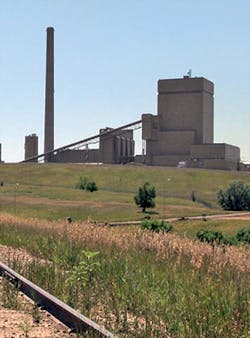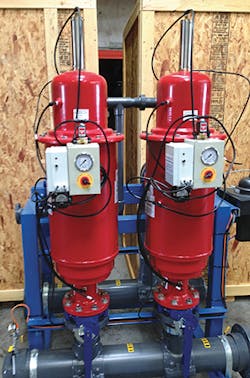TRADITIONAL NUCLEAR OR fossil fuel power plants utilize feedwater to generate the steam to drive turbines and power electric generators. While steam-generated power provides reliable electricity to many Americans, one often overlooks the need to treat the feedwater and the chemically polluted wastewater that’s produced.
Common pollutants in feedwater and steam generator wastewater include salts, metals, and organic chemicals. When this heavily contaminated produced water is introduced to the surrounding environment, it can leach into groundwater supplies, impact sensitive animal and plant communities, and also become a public health hazard.
Current technologies to clean industrial wastewater rely on membranes to sieve contaminants from produced water. While membranes effectively remove large contaminants like solids, hydrocarbons, salts, and pathogens, they are easily clogged and do not remove smaller contaminants like chlorine and pesticides, which have a smaller molecular size than water itself. Due to the high maintenance costs and the inability to remove small contaminants from wastewaters, these traditional treatment technologies no longer meet the needs of the modern industrial operation. Our industries are in need of a new solution to better manage our most precious natural resource.
Across the US, several key factors impact technology upgrades:
Tightening regulations despite aging infrastructure. Without the required infrastructure updates, domestic industries cannot scale efficiently. A recent report from the American Water Works Association (AWWA) estimates that the country requires an additional trillion-dollar investment in water and wastewater infrastructure over the next 25 years. In addition to outdated infrastructure, growing environmental consciousness is also driving strict water use and disposal regulations across the country. New EPA standards now place the heavy lifting on industrial managers rather than utilities—facilities must now update their water practices to meet the regulatory requirements of today and those of the future. As water use is monitored more closely and industrial wastewater regulations tighten, many operators are faced with the task of updating their existing treatment systems.
Growing water scarcity and technological innovation. Extreme water shortages are also affecting both industrial and residential water management practices. For example, severe drought is tightening water management in California, where new standards are cropping up to better conserve water across the value chain. To sustainably consume water resources and minimize the disposal of large amounts of wastewater, regulators have tightened rules to promote the installation of efficient wastewater treatment technologies at industrial sites. For example, the EPA’s rules and regulations for steam boilers in the US were updated in September 2015 and call for the elimination of toxic metals from waste streams. The new rule will reduce the amount of water thrown away and promote healthy reintroduction into natural and municipal water systems. The rule had not been updated since 1982 and due to advancements in wastewater technology and the high-efficiency treatment schema available today, regulators decided to refresh the water standard. As legislation continues to tighten, operators are seeking an environmentally friendly water treatment alternative that won’t break the bank.
Lack of in-house resources. Purchasing or updating a wastewater treatment system requires a large investment of both time and resources. Companies must complete water analyses, evaluate technologies, develop plans, assess vendors and budgets, and evaluate proposals before beginning installation. Due to the resource-heavy burden associated with installing appropriate treatment systems, many utilities are choosing to outsource their water management rather than employ an in-house specialist. External water treatment experts assist utilities by taking on the engineering, installation, and operation of new water equipment and services so facility personnel can devote more time to meeting core business goals. Outsourcing is a quick and easy way for utilities to ensure updated water treatment solutions are properly installed and efficiently operating. Specialists can also manipulate treatment to maximize efficiency and minimize supply costs associated with onsite treatment and disposal.
Water service leader OriginClear is up to the challenge. The company provides outsourced treatment technologies that reduce operational and maintenance costs at the treatment site. OriginClear works with subsidiary Progressive Water Treatment (PWT) to provide innovative and customized wastewater treatment solutions to industrial, municipal, and ultrapure water (UPW) customers. Through outsourced wastewater management, operators can spend less time and fewer resources on engineering and focus on other areas of their business.
CASE STUDY: MODERN WASTEWATER TREATMENT COMES TO A NORTH DAKOTA UTILITY
At Otter Tail Power Company’s Coyote Station, located in Beulah, ND, existing wastewater treatment infrastructure was in desperate need of an update. The cold lime softener, clear-well, and multiple pressure systems in place at the coal-fired power plant were aging rapidly—operators needed a solution to improve the quality of treated water entering onsite steam generators. In the spring of 2014, Otter Tail operators decided it was time to take action.
As existing municipal and industrial infrastructure ages, hazardous waste disposal costs rise, and water scarcity grows increasingly extreme, utility managers are eager to adopt advanced wastewater treatment technologies to address these economic and operational challenges. Otter Tail Power chose to outsource this to OriginClear-subsidiary and leading water services company Progressive Water Treatment (PWT), experts in wastewater treatment.
PWT engineers worked closely with Otter Tail managers to maximize output efficiency and minimize maintenance costs at Coyote Station without sacrificing the quality of produced water. PWT quickly constructed, installed, and launched a twin 300 GPM ultrafiltration membrane system onsite at Otter Tail’s Coyote Station. In PWT’s solution, initial treatment with an ultrafiltration membrane filters the feedwater before it enters a reverse osmosis membrane system. By combining both ultrafiltration and reverse osmosis technologies, feedwater is optimally cleaned before it enters Coyote Station’s steam generators. The new system can process up to 800,000 gallons of feedwater per day.
Installed in May 2016, the system should enable Coyote Station to reduce chemical supply costs, improve system performance, decrease maintenance frequency and provide consistently high-quality steam generator feed water.


